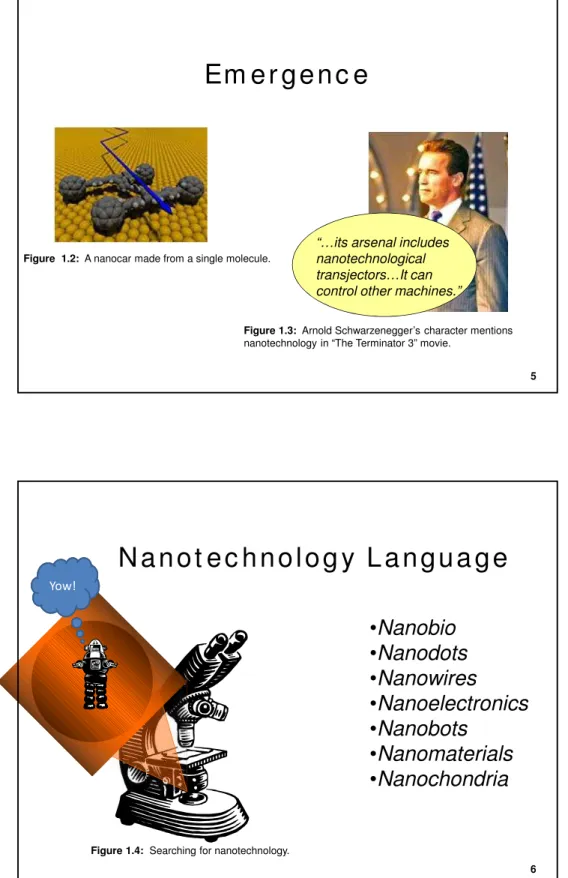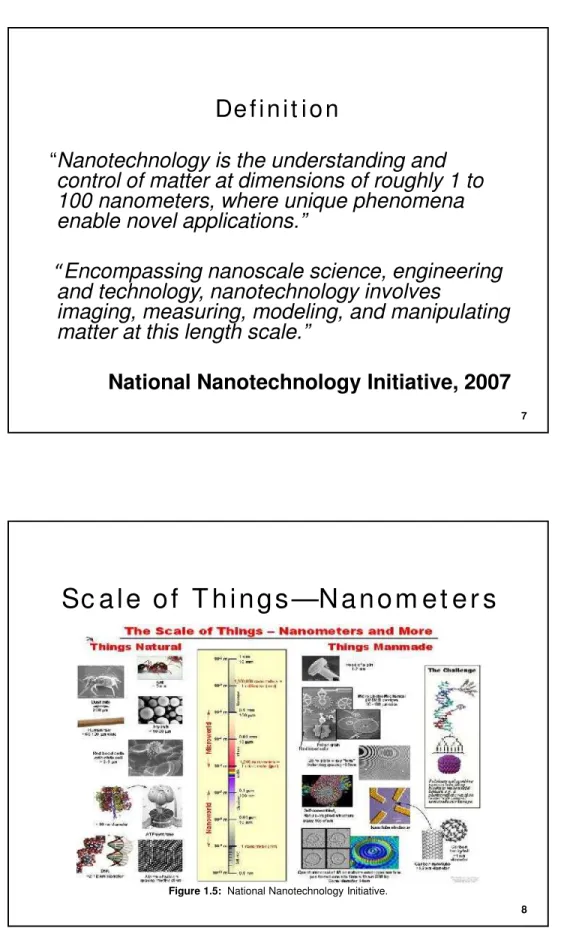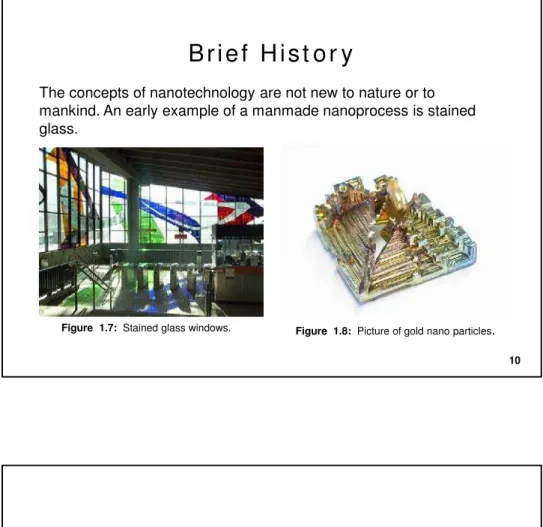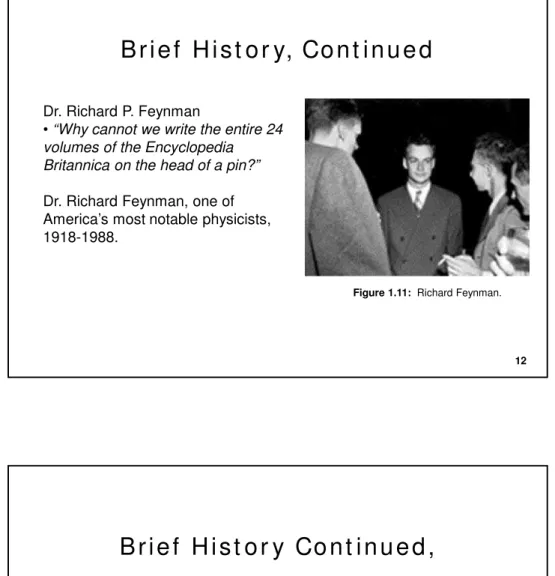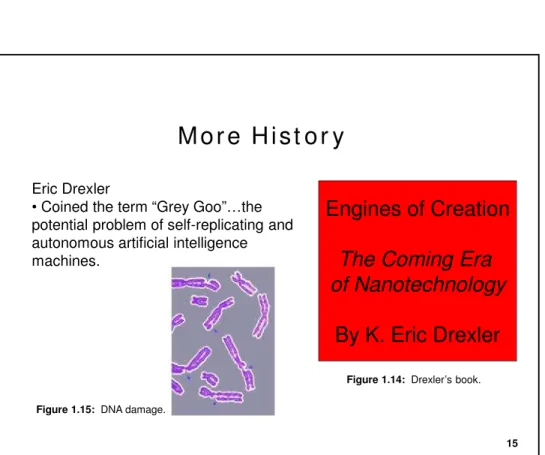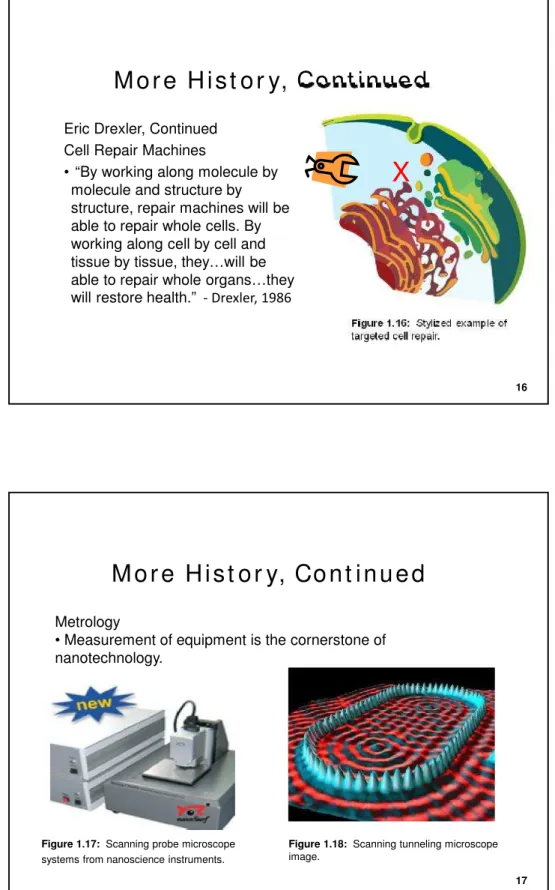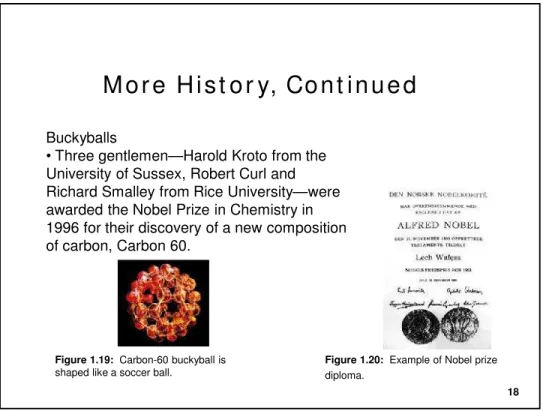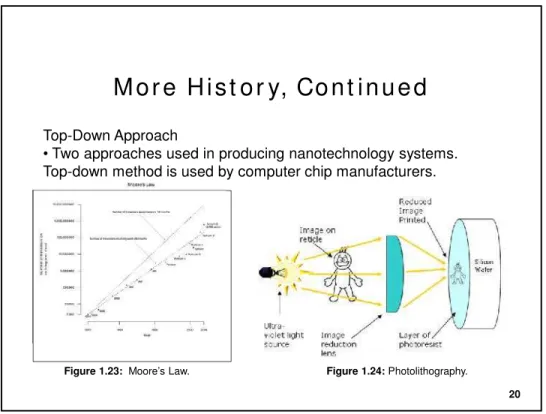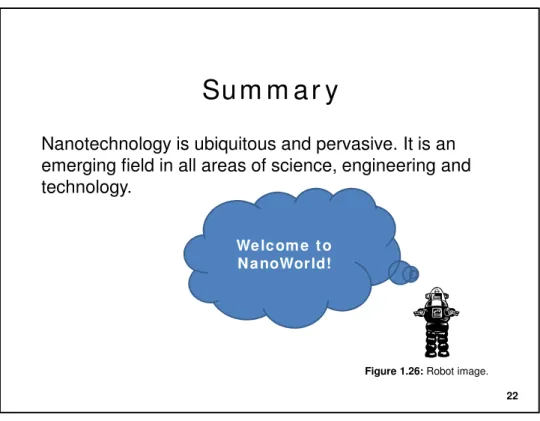I n t r o d u c t i o n t o
N a n o t e c h n o l o g y
1
Ob j e c t i ve
The purpose of this module is to
introduce the emerging
To p i c s
• Nanotechnology Terms and Definitions
• History of Nanotechnology
• Current and Future Trends, Research and
Applications
3
Where does your imagination take you?
Figure 1.1:
Pr e f a c e
Is nanotechnology the
gateway to the
Figure 1.3:Arnold Schwarzenegger’s character mentions nanotechnology in “The Terminator 3” movie.
“…its arsenal includes nanotechnological transjectors…It can control other machines.” Figure 1.2:A nanocar made from a single molecule.
Em e r g e n c e
5
N a n o t e c h n o l o g y L a n g u a g e
•
Nanobio
•
Nanodots
•
Nanowires
•
Nanoelectronics
•
Nanobots
•
Nanomaterials
•
Nanochondria
Yow! Yow!
De f i n i t i o n
“
Nanotechnology is the understanding and
control of matter at dimensions of roughly 1 to
100 nanometers, where unique phenomena
enable novel applications.”
Encompassing nanoscale science, engineering
and technology, nanotechnology involves
imaging, measuring, modeling, and manipulating
matter at this length scale.”
National Nanotechnology Initiative, 2007
7
Figure 1.5: National Nanotechnology Initiative.
B r i e f H i s t o r y
Figure 1.7: Stained glass windows. Figure 1.8:Picture of gold nano particles.
10
The concepts of nanotechnology are not new to nature or to mankind. An early example of a manmade nanoprocess is stained glass.
B r i e f H i s t o r y, Co n t i n u e d
Figure 1.9:Tokyo Science University.
Birth of Nanotechnology
• Professor Taniguchi of Tokyo Science University used the word “nanotechnology” to describe the science and technology of processing or building parts with nanometric tolerances.
•A nanometer is a unit of length in the metric system, equal to one billionth of a meter.
B r i e f H i s t o r y, Co n t i n u e d
Dr. Richard P. Feynman
•“Why cannot we write the entire 24 volumes of the Encyclopedia Britannica on the head of a pin?”
Dr. Richard Feynman, one of America’s most notable physicists, 1918-1988.
Figure 1.11: Richard Feynman.
12
B r i e f H i s t o r y Co n t i n u e d ,
Dr. Feynman, Continued
• “The problems of chemistry and biology can be greatly helped if our ability to see what we are doing, and to do things on an atomic level, is ultimately developed – a
development which I think cannot be avoided.”
Figure 1.12:Collection of reminiscences by Nobel Prize-winning physicist.
Surely You’re
Joking
Mr. Feynman!
Adventures of a Curious Character
B r i e f H i s t o r y, Co n t i n u e d
Atomic Scale
• A computer image of the nano ice double helix.
• In the nano ice image, oxygen atoms are blue in the inner helix, purple in the outer helix. Hydrogen atoms are white.
Figure 1.13:A nanotechnology self-assembly process.
14
M o r e H i s t o r y
Figure 1.15:DNA damage.
Figure 1.14:Drexler’s book.
Engines of Creation
The Coming Era
of Nanotechnology
By K. Eric Drexler
Eric DrexlerM o r e H i s t o r y, Co n t i n u e d
Eric Drexler, Continued Cell Repair Machines
• “By working along molecule by molecule and structure by structure, repair machines will be able to repair whole cells. By working along cell by cell and tissue by tissue, they…will be able to repair whole organs…they will restore health.” - Drexler, 1986
Figure 1.16:Stylized example of targeted cell repair.
16
X
M o r e H i s t o r y, Co n t i n u e d
Figure 1.17:Scanning probe microscope systems from nanoscience instruments.
Figure 1.18:Scanning tunneling microscope image.
Metrology
M o r e H i s t o r y, Co n t i n u e d
Figure 1.19:Carbon-60 buckyball is shaped like a soccer ball.
Buckyballs
• Three gentlemen—Harold Kroto from the University of Sussex, Robert Curl and Richard Smalley from Rice University—were awarded the Nobel Prize in Chemistry in 1996 for their discovery of a new composition of carbon, Carbon 60.
Figure 1.20:Example of Nobel prize diploma.
18
M o r e H i s t o r y, Co n t i n u e d
Figure 1.22:Dome over biosphere in Montreal.
Figure 1.21:A “Buckyball.” Fullerenes
M o r e H i s t o r y, Co n t i n u e d
Figure 1.23:Moore’s Law. Figure 1.24:Photolithography.
20
Top-Down Approach
• Two approaches used in producing nanotechnology systems. Top-down method is used by computer chip manufacturers.
M o r e H i s t o r y, Co n t i n u e d
Figure 1.25:An example of a molecular self assembly through hydrogen bonds. Bottom-Up Approach
What do scientists and engineers thinks of
nanotech
?
•
Nanoscale engineering, science, and
technology have captured the imagination of
many scientists and engineers. At the
nanometer scale, different disciplines seem to
cross their traditional borders and collaborate.
•
Electrical engineers tend to think of
•
Chemists tend to see nanotechnology as the
"science of making things big." They grapple
with connecting their largest molecules to
even larger electronic or photonic structures
to have them interact with electric circuits or
with light.
•
Material scientists seem to think of
•
For biologists, nanoscale represents the
fundamental length scale of a DNA and basic
energy conversion. Understanding
measurements and chemical details at the
10nmlength scale presents a challenge of this
community.
•
Nanotechnology has applications in medicine,
energy, information and communication,
consumer goods, and more. Some areas are
more mature than others.
•
For example, the entire semiconductor
•
Transistors with critical dimensions of 30nm
are being built today and put together into
circuits composed of over one billion devices,
on one single chip, roughly the size of a
thumbnail.
•
In medicine, nanotechnology has led to the
•
There are advanced uses of nanotechnology in
areas of storage, conversion, and renewal of
energy from LEDs to fuel cells to solar cells.
•
Most high-tech information and
communication devices use nanoscale
production processes.
•
Nanotechnology is also found in everyday
consumer goods, such as stain-resistant fibers
for clothes, tennis balls, running shoes,
We lc om e t o N a noWorld!
Figure 1.26:Robot image.
Su m m a r y
22
Nanotechnology is ubiquitous and pervasive. It is an
emerging field in all areas of science, engineering and
technology.
Re fe r e n c e s
• American Ceramic Society (2006, March). Overview of Safety, Risks. American Ceramic Society Bulletin. Vol. 85 Issue 3, p6, 1/6 p.
• Booker, Richard & Boysen, Earl (2005). Nanotechnology for Dummies. NJ: Wiley Publishing Inc.
• Diott, D.D. (2006, April). Thinking big (and small) about energetic materials. Material Science and Technology. Vol. 22 Issue 4. p. 463, 11p.
• Drexler, K. Eric (1986). Engines of Creation: The Coming Era of Nanotechnology. New York: Anchor Books.
• Henderson, Donald (2006). Bioterrorism: Interview with Donald Henderson. Asia Pacific Biotech News. Vol. 10, Issue 1, p.18, 9p.
Re fe r e n c e s , Co n t i n u e d
24
• Lane, Neal & Kalil, Thomas (2005). The National Nanotechnology Initiative: Present at the creation. Issues in Science & Technology; Summer 2005. Vol 21, p49, 6p.
• Lieberman, Marya (2007). Self-assembled monolayers and multilayers of phthalocyanines. University of Notre Dame: Department of Chemistry and Biochemistry. Retrieved 7/02/2007 from http://www.nd.edu/~mlieberm/ • Mandal, Deendayal; Bolander, Mark E.; Mukhopadhyay, Debrabrata; Sarkar, Gobinda;
• Mukherjee, Priyabrata (2006, January). The use of Microorganisms for the formation of metal nanoparticles and their application. Applied Microbiology and Biotechnology. Vol. 69 Issue 5, p. 485, 8p.
• Mostow, Jonathan (Director). (2003). Terminator 3: Rise Of The Machines [Motion Picture]. United States: Warner Bros. Pictures.
Re fe r e n c e s , Co n t i n u e d
• Murday, James F. (2005). Nanotechnology: Hype and Hope in Aerospace Applications. Advanced Materials and Processes. Vol. 163, Issue 12, P. 21, 2p.• Nanotechnology at UT Austin (2007). Graduate Portfolio Program. Retrieved 6/27/2007 from http://www.cnm.utexas.edu/graduateportfolio.html • Nanotechnology Now (2006, March). Nanotechnology documentary to be filmed at nanoTX’06. Retrieved 7/02/2007 from http://www.nanotech-now.com/news.cgi?story_id=14281
Re fe r e n c e s , Co n t i n u e d
26
• Ratner, Mark & Ratner, Daniel (2003). Nanotechnology: A Gentle Introduction to the Next Big Idea. New Jersey: Prentice Hall PTR.
• Rouekes, M. L., Fritz, S., Stix, G., Whiteside, G.M., Love, J.C., Alivisatos, A.P. et al. (2002). Understanding Nanotechnology: Scientific American. New York: Warner Books.
• Terra, Richard P. (2000, March). National Nanotechnology Initiative in FY2001 Budget: Clinton Administration Requests $497 million for NT-Related R&D Funding. Foresight Nanotech Institute. Retrieved 4/02/2007 from http://www.foresight.org/Updates/Update40/Update40.1.html
• UNL News Releases (2006, December). Self-assembling nano-ice discovered at UNL; structure resembles DNA. Retrieved 6/28/2007 from http://ucommxsrv1.unl.edu/unlnews/public/fmpro?-db=unlnews.fp5&-format=newsrelease.shtml&-lay=unlnews&-recid=33994&-find=
Re fe r e n c e s
• Wikipedia (2007). Moore’s Law. Retrieved 7/02/2007 from http://en.wikipedia.org/wiki/Moore%27s_law• Wikipedia (2007). Nature. Retrieved 7/05/2007 from http://en.wikipedia.org/wiki/Category:Nature
• Wong, H.S. Philip (2006, March). Nanoelectronics – Opportunities and Challenges. International Journal of High Speed Electronics and Systems. Vol. 16, Issue 1, p. 83, 12p.
• Yamaguchi, Tomohiko; Epstein, Irving; Shimomura, Masatsugu; & Kunitake, Toyoki (2005, December). Vol. 15, Issue 4, p. N, 3 p.
